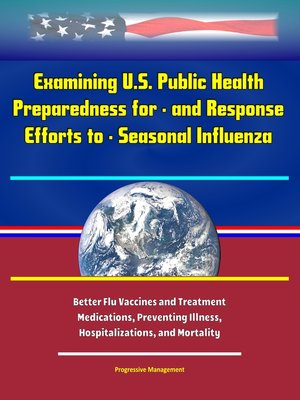Examining U.S. Public Health Preparedness for
ebook ∣ and Response Efforts to--Seasonal Influenza--Better Flu Vaccines and Treatment Medications, Preventing Illness, Hospitalizations, and Mortality

Sign up to save your library
With an OverDrive account, you can save your favorite libraries for at-a-glance information about availability. Find out more about OverDrive accounts.
Find this title in Libby, the library reading app by OverDrive.



Search for a digital library with this title
Title found at these libraries:
| Loading... |
This important House hearing heard from witnesses about the U.S. level of preparedness for dealing with seasonal influenza. Representative Harper noted in his opening statement: Influenza is a leading cause of death in the United States, especially in a severe flu season. Every year, thousands of Americans die from the flu and thousands more are hospitalized from flu-related complications. Since 2010, the flu has caused between 12,000 and 56,000 deaths per year. The best way to prevent the flu is by getting your flu shot. Millions of Americans receive a flu shot every year to help protect them against this illness. Unfortunately, there are many Americans that do not do that. Last year, only 59 percent of children and about 43 percent of adults received flu vaccination.
Even though only a little over half of Americans typically get vaccinated, CDC estimates that flu vaccination prevented 3,000 pneumonia and influenza deaths during the 2015-2016 flu season alone. Increasing the number of Americans that get the annual flu vaccine will prevent more deaths and illnesses. Not only can the flu vaccine help prevent an individual from getting the flu, but it also helps reduce severe outcomes when someone does get sick with the flu. During past seasons, about 80 percent of flu-associated deaths in children have occurred in children who were not vaccinated. Similarly, a recent study found that receiving the flu vaccine reduced severe outcomes in hospitalized patients by reducing deaths, reducing ICU admissions, reducing ICU length of stays, and reducing overall length of stay for hospital patients. While the flu vaccine is currently the best tool to prevent illness, there is room for improvement. The CDC recently announced that this year's flu vaccine was only about 36 percent effective in preventing an individual from getting the flu. The vaccine's effectiveness varied from different age groups and for different strains of the virus. For example, the vaccine was 59 percent effective in children. However, it was much less effective in adults. For all age groups, the vaccine was only 25 percent effective this season against the deadliest strain of the flu, H3N2.
This compilation includes a reproduction of the 2019 Worldwide Threat Assessment of the U.S. Intelligence Community.






